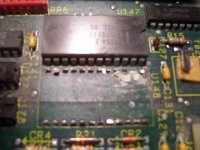Finally got back again, had 1 inch ice storm,no power for 1 1/2 weeks and lots of things to do to get machinery operating at work.
Got the MC chip in, looks good to me anyway, no burn on mobo etc.
Got it reassembled and turned it on and didn't get shut down error I had before. But!! it won't boot up (Hopefully I connected something wrong when I reassembled) I get 2 short beeps, then nothing. No video or anything. When I get to work and have time am going to reseat video board.
On the good side I found the manual for the machine, and it should have all information I need, down to all schematics, including the mobo.
Question; under power supply on corner of board is a 2 pin connector that shows to be power test. marked as c142 on board, but j26b on schematis 7 pin out. I think it had 1 wire hooked to it, red from supply, in a 4 pin connector but only 2nd pin in connector used, I have hooked this wire to positive on pin out, does this sound right?
On front panel connector is a 2 pin reset connect, Have reset button hooked to it, the 2 wires from reset switch go in a 4 or 5 pin connector with 3 wires cut off.
3 pin speaker pins are no problem.
5 pin connector for key lock, led etc, has no wire for it or I have lost it.
Key lock switch goes to what looks like a mercury switch to power pc & controls for attached drive unit.
Should there be something on the key lock pins?


